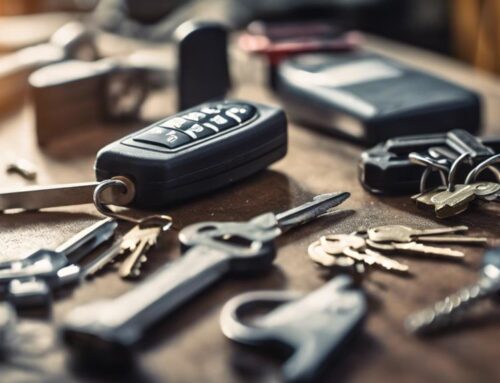Like a modern-day magician pulling rabbits from hats, locksmiths rely on an array of specialized tools for transponder key programming. You might be surprised to learn that it's not just about having a key cutter; a transponder key programmer, OBD-II scanner, and even an EEPROM reader play essential roles. Each piece of equipment serves a purpose, ensuring seamless communication with a vehicle's onboard systems. But what might catch your interest most is how these tools work together to navigate the complexities of modern vehicle security systems.
Key Takeaways
- Locksmiths use transponder key programmers for accurate programming and duplication of transponder keys across various vehicle models.
- OBD-II scanners access vehicle diagnostic systems for programming, troubleshooting, and real-time data extraction.
- EEPROM readers are essential for reading and writing data from vehicle control modules, facilitating effective key cloning and modification.
- Key cutting machines, including manual and automatic types, are used to create precise key duplicates tailored to specific key designs.
- Advanced software applications streamline the programming process, providing access to manufacturer databases and assisting in real-time diagnostics.
Transponder Key Programmer
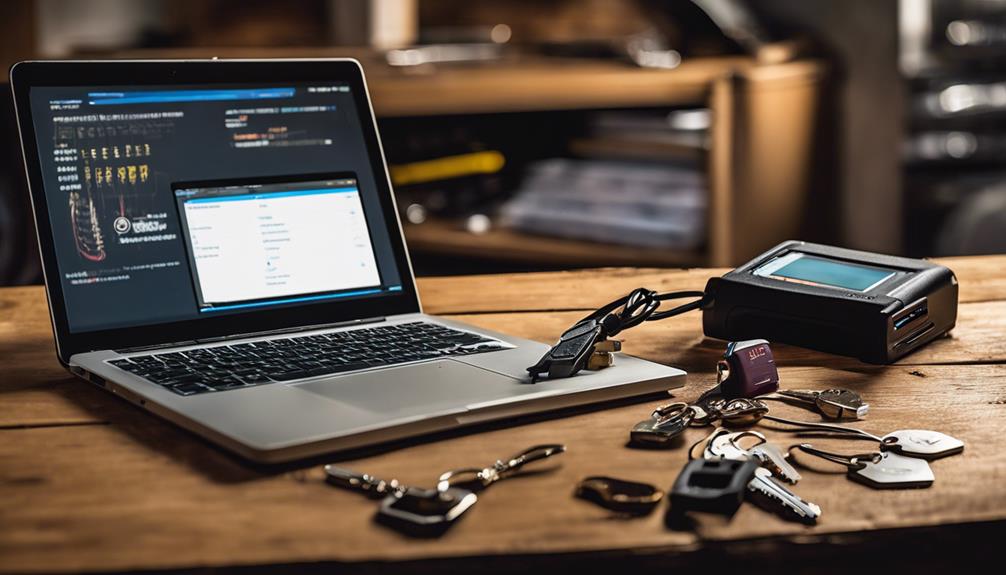
A locksmith's transponder key programmer is an essential tool for efficiently programming and reprogramming transponder keys. This device leverages advanced transponder key technology to guarantee precise communication between the key and the vehicle's ignition system. By utilizing various key programming methods, you can program keys quickly, enhancing your service capabilities. Whether you're duplicating existing keys or creating new ones, this tool simplifies complex tasks, allowing you to maintain control over your operations. You'll appreciate the speed and reliability it brings to your workflow, making you more competitive in the locksmith industry. Mastering this technology not only expands your skill set but also empowers you to tackle a broader range of automotive security challenges with confidence. Nationwide Transponder Car Key Programming Service by Low Rate Locksmith
Diagnostic Tools
Effective diagnostic tools are essential for any locksmith specializing in transponder key programming. These tools enable you to analyze vehicle systems, ensuring accurate key programming techniques. With diagnostic tool advancements, you can quickly identify issues that might prevent successful programming, such as faulty sensors or communication errors. Additionally, having access to cutting-edge diagnostic equipment allows you to stay updated on the latest automotive technologies, providing real-time data that enhances your programming accuracy. You'll find that having these tools at your disposal not only streamlines your workflow but also empowers you to deliver precise solutions to your clients. Ultimately, mastery of diagnostic tools elevates your locksmithing capabilities, ensuring you remain competitive in the ever-evolving automotive landscape.
Key Cutting Machines

When it comes to key cutting machines, understanding the different types of key cutters is essential for efficient transponder key programming. Each machine operates through a specific key cutting process that can affect accuracy and speed. Familiarizing yourself with these tools will enhance your locksmithing capabilities and improve service quality. Locksmiths need to be proficient in using various key cutting machines to accurately duplicate keys, including essential tools for car key cutting to handle advanced key types.
Types of Key Cutters
Key cutters play an essential role in the locksmith's toolkit, particularly for transponder key programming. Various key types require specific cutting techniques to guarantee precise duplication. The most common types of key cutters include manual, semi-automatic, and fully automatic machines. Manual cutters allow for greater control and are ideal for unique key types, while semi-automatic machines enhance efficiency without sacrificing accuracy. Fully automatic cutters streamline the process, making them perfect for high-volume operations. Each cutter utilizes different techniques, such as edge-cutting or laser-cutting, tailored to the key's design. Understanding these differences is significant for delivering exceptional service and maintaining security standards in transponder key programming. Locksmiths often rely on advanced technology to guarantee the precision and accuracy required for transponder key programming.
Key Cutting Process
The key cutting process is a critical step in preparing transponder keys for programming, directly influencing the accuracy of the duplicate. You'll employ advanced key cutting machines that utilize precise key duplication techniques, ensuring that each cut mirrors the original key's specifications. This precision is essential, especially for remote keyless entry systems, where even slight inaccuracies can prevent the key from functioning correctly.
As you guide the machine through the cutting process, you'll monitor the alignment and depth of each cut meticulously. This attention to detail guarantees that the new key not only fits the lock but also communicates effectively with the vehicle's transponder system. Mastering this process equips you with the power to deliver reliable, high-quality duplicates every time.
OBD-II Scanners
OBD-II scanners play an essential role in transponder key programming by allowing you to access the vehicle's onboard diagnostic system. They facilitate the programming process by reading and writing data to the key and vehicle, which can help troubleshoot common compatibility issues. Understanding how to effectively use these scanners will enhance your efficiency in key programming tasks. Locksmiths can also utilize these scanners to extract relevant information needed for programming transponder keys without originals and guarantee proper functioning of the newly programmed keys.
Functionality of OBD-II Scanners
When it comes to modern vehicle diagnostics, OBD-II scanners play an essential role in transponder key programming. These powerful tools interface with your vehicle's onboard computer, allowing you to extract vital data related to transponder technology and automotive security. By using an OBD-II scanner, you can efficiently diagnose issues, program keys, and guarantee that the vehicle's security systems are functioning at their best. Additionally, locksmiths can access real-time data about vehicle performance and faults, enabling them to provide accurate solutions for troubleshooting common transponder key issues.
- Access real-time data about vehicle performance and faults.
- Program and synchronize new transponder keys with the ECU.
- Perform advanced diagnostics that enhance automotive security measures.
With the ability to quickly read and interpret codes, OBD-II scanners empower locksmiths to provide effective solutions, guaranteeing that you maintain control over your vehicle's security.
Programming Process Overview
Utilizing OBD-II scanners for transponder key programming involves a systematic approach that guarantees successful synchronization with the vehicle's ECU. First, you'll connect the scanner to the OBD-II port and initiate the programming mode. Depending on the transponder key types involved, you'll input specific vehicle information to ascertain compatibility. This step is vital, as programming challenges can arise from mismatched data or incorrect procedures. For further details on the factors influencing programming costs, check out Understanding the Cost of Programming Transponder Keys. Next, follow the on-screen prompts to program the transponder key, making sure each command is executed precisely. Once the programming is complete, test the key to confirm proper function. This method not only streamlines the process but also enhances your efficiency as a locksmith, empowering you to tackle various transponder key programming tasks with confidence.
Common Compatibility Issues
Compatibility issues often arise during transponder key programming with OBD-II scanners, impacting the overall effectiveness of the process. You may encounter several key programming challenges that can hinder your success:
- Vehicle-Specific Protocols: Different manufacturers use unique communication protocols, complicating compatibility.
- Software Limitations: Not all scanners have the latest updates, leading to potential transponder compatibility issues.
- Hardware Constraints: Older OBD-II scanners may lack the necessary features to program newer transponder keys.
Understanding these factors is vital for successful programming. To optimize your key programming efforts, verify your equipment is up-to-date and compatible with the specific vehicle model you're working on. By addressing these compatibility issues proactively, you can enhance your efficiency and effectiveness in the field.
EEPROM Readers
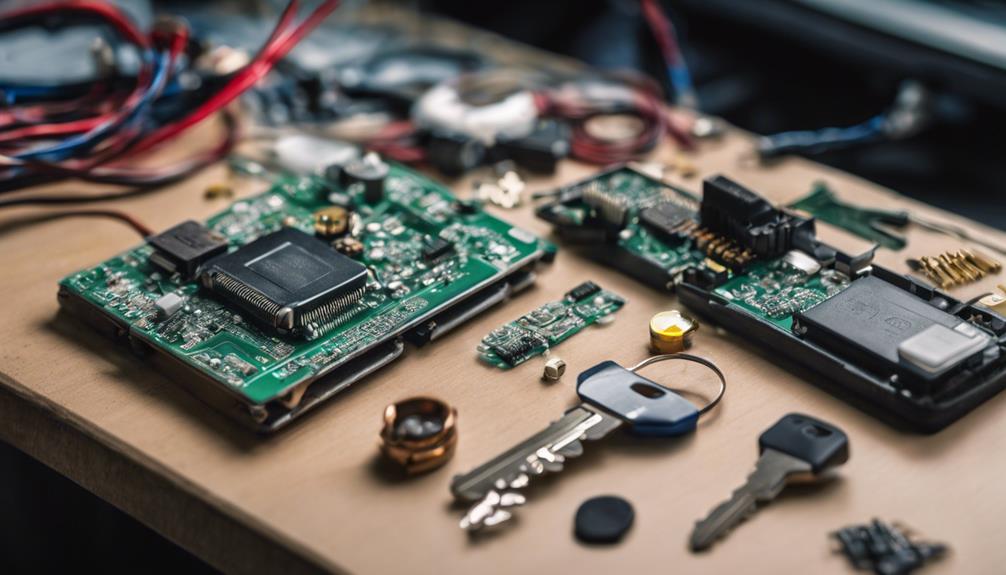
Precision is key in the world of transponder key programming, and EEPROM readers play an essential role in this process. These advanced devices utilize EEPROM technology to read and write data from vehicle control modules, enabling you to extract and program transponder keys accurately. With the ability to handle various EEPROM applications, these readers allow you to access critical data embedded in the chips, ensuring you can effectively clone or modify keys as needed. By mastering EEPROM readers, you gain a significant advantage in the locksmithing field, empowering you to tackle complex programming tasks with confidence. Investing in reliable EEPROM technology not only enhances your capabilities but also elevates your service offerings, making you a sought-after professional in the industry. Locksmiths rely on EEPROM readers for precise key programming, especially for high-security and luxury models.
Software Applications
After mastering EEPROM readers, locksmiths can utilize advanced software applications to complement their tools in transponder key programming. These applications streamline the programming process, providing access to manufacturer-specific databases for accurate key data and real-time diagnostics for troubleshooting programming issues. Integration with various hardware tools guarantees seamless operation, while user-friendly interfaces make it easier to navigate through various functions.
Programming Blank Keys
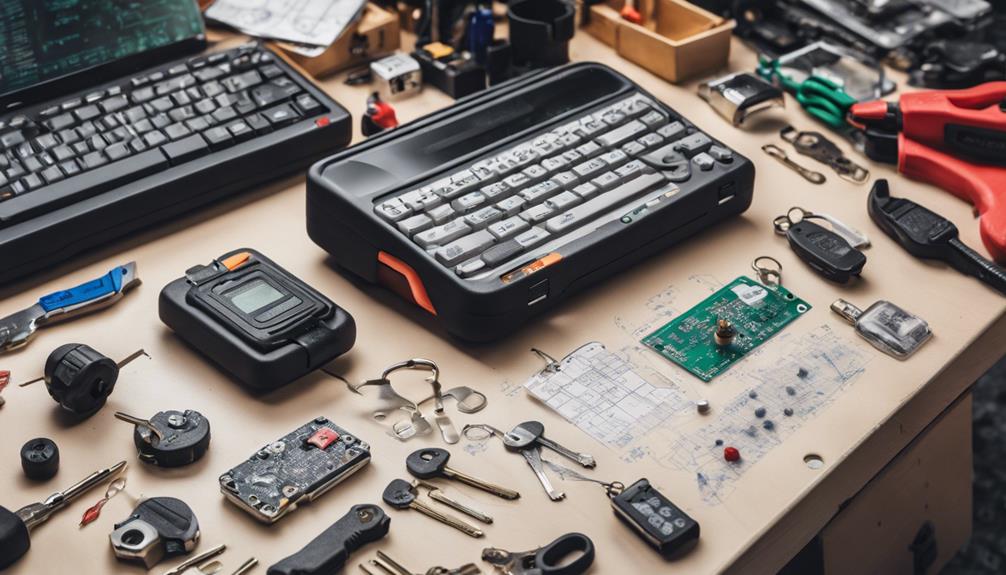
When it comes to programming blank keys, locksmiths need to immerse themselves in the specifics of the vehicle's key system. You'll utilize advanced key programming techniques, which require a thorough understanding of various vehicle models and their unique coding systems. The latest programming equipment advancements have made this process more efficient and precise, allowing you to program keys with greater accuracy. You'll often rely on specialized tools that interface directly with the vehicle's onboard computer, ensuring compatibility and functionality. Mastering these techniques not only enhances your skill set but also empowers you to provide top-tier services to clients. By staying informed about evolving technologies, you can remain competitive in this rapidly advancing field.
Security Bypass Tools
In today's locksmithing landscape, security bypass tools play an essential role in efficiently programming transponder keys. These tools allow you to navigate complex security protocols, enabling you to implement effective bypass techniques. With the right equipment, you can streamline the process, ensuring that you meet customer needs swiftly and securely.
- Key Programmers: Specialized devices that facilitate communication with the vehicle's ECU.
- EEPROM Readers: Tools for extracting data from the key's electronic chip, crucial for programming.
- Diagnostic Scanners: Essential for troubleshooting and ensuring compatibility with various vehicle models.
Low Rate Locksmith Technology
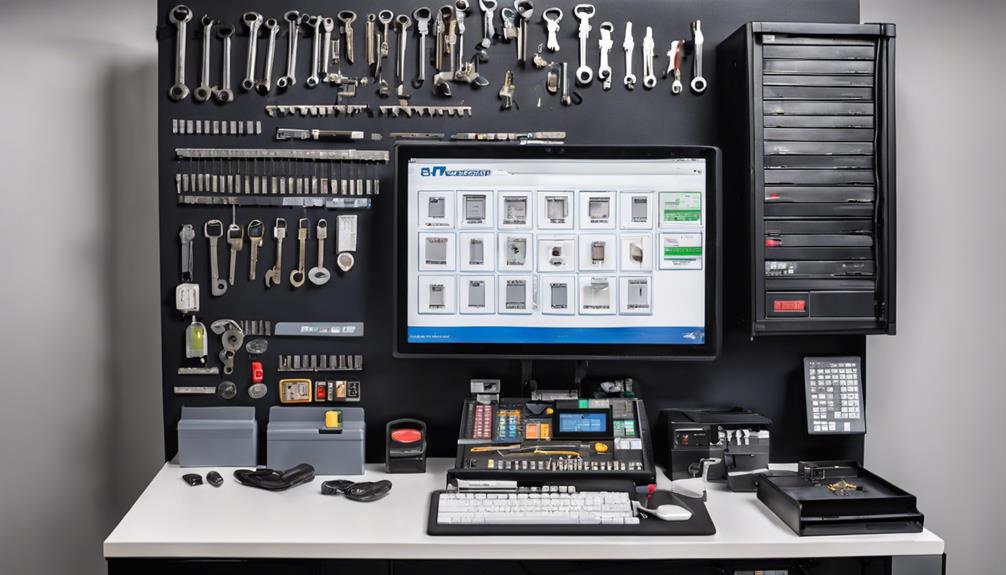
Utilizing low rate locksmith technology can greatly enhance your efficiency and profitability in the locksmithing business. By investing in budget-friendly technology, you can offer services that rival those of more expensive competitors while maintaining quality. Affordable locksmiths often leverage these tools to streamline operations, allowing for quicker response times and improved customer satisfaction. For instance, using portable key programmers can greatly reduce the time needed for transponder key programming, leading to increased job volume. Additionally, integrating mobile apps for remote diagnostics can help you diagnose issues on-site, saving you time and resources. Embracing these low-rate technologies not only maximizes your profits but also positions you as a forward-thinking locksmith in an increasingly competitive market.







